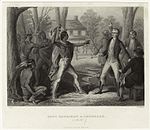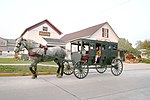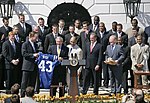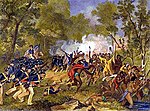Portal:Indiana/Selected article
| This page is currently inactive and is retained for historical reference. Either the page is no longer relevant or consensus on its purpose has become unclear. To revive discussion, seek broader input via a forum such as the village pump. |
| Note: Article entries are now being transcluded directly on the main portal page. However, this page should be retained for historical reference. |
Usage
The layout design for these subpages is at Portal:Indiana/Selected article/Layout.
- Add a new Selected article to the next available subpage.
- Update "max=" to new total for its {{Random portal component}} on the main page.
Selected article
Purdue University is a public university located in West Lafayette, Indiana, USA. It serves as the primary of six campuses affiliated with the Purdue University System, one of the largest university systems in the nation.
A land-grant university, Purdue was founded on May 6, 1869, when the Indiana General Assembly, taking advantage of the Morrill Act, accepted a donation of land and money from Lafayette businessman John Purdue to establish a college of science, technology, and agriculture in his name. The first classes were held on September 16, 1874, with three buildings, six instructors, and 39 students. Today, Purdue enrolls the largest student body of any university in Indiana and the largest international student population of any public university in the United States.
In 2005, Purdue reorganized its academic units into its present configuration of eight colleges and fourteen schools, containing both undergraduate and graduate programs in over 200 major areas of study.
Purdue has devoted a significant portion of its endowment to research activities in recent years, particularly in emerging high technology fields related to bioscience and bioengineering.
Portal:Indiana/Selected article/2
USS Indianapolis (CA-35) was a Portland-class heavy cruiser of the United States Navy. She holds a place in history due to the notorious circumstances of her loss, which was the worst single at-sea loss of life in the history of the U.S. Navy. After delivering the first atomic bomb to be used in combat to the United States air base at Tinian Island on 26 July 1945, she was in the Philippine Sea when attacked at 00:14 on 30 July 1945 by a Japanese submarine. Most of the crew was lost to shark attacks, as they floated helplessly for several days, waiting for assistance. Indianapolis was the second to last US Navy ship sunk by enemy action in World War II (The submarine USS Bullhead was attacked by Japanese aircraft with depth charges and sunk on 6 August 1945).
Indianapolis was laid down on 31 March 1930 by the New York Shipbuilding Corp.; launched on 7 November 1931; sponsored by Miss Lucy Taggart, daughter of the late Senator Thomas Taggart; and commissioned at the Philadelphia Navy Yard on 15 November 1932. The USS Indianapolis National Memorial was dedicated on August 2, 1995. It is located on the Canal Walk in Indianapolis. Some material relating to the USS Indianapolis is held by the Indiana State Museum.
Portal:Indiana/Selected article/3
Tecumseh's War or Tecumseh's Rebellion are terms sometimes used to describe a conflict in the Old Northwest between the United States and an American Indian confederacy led by the Shawnee chief Tecumseh. Although the war is often considered to have climaxed with William Henry Harrison's victory at the Battle of Tippecanoe in 1811, Tecumseh's War essentially continued into the War of 1812 and is frequently considered a part of that larger struggle.
The two principal adversaries in the war, Tecumseh and William Henry Harrison, had both been junior participants in the Battle of Fallen Timbers at the close of the Northwest Indian War in 1794. Tecumseh had declined to sign the Treaty of Greenville that had ended the war and ceded much of present-day Ohio to the United States. After the Greenville Treaty, most of the Ohio Shawnees settled at the Shawnee village of Wapakoneta on the Auglaize River, where they were led by Black Hoof, a senior chief who had signed the treaty. Little Turtle of the Miamis, who had also participated in the earlier war and signed the Greenville Treaty, lived in his village on the Eel River. Both Black Hoof and Little Turtle urged cultural adaptation and accommodation with the United States.
Portal:Indiana/Selected article/4
The Indianapolis 500-Mile Race, often shortened to Indianapolis 500 or Indy 500, is an American automobile race, held annually over the Memorial Day weekend at the Indianapolis Motor Speedway in Speedway, Indiana. The event, billed as "The Greatest Spectacle in Racing", is one of the oldest and richest motorsport events in existence, having the largest attendance and one of the largest radio and television audiences of any single-day sporting event worldwide. While the official attendance is not disclosed by Speedway management, news media estimate attendance in excess of 270,000.
The event lends its name to the "IndyCar" class of formula, or open-wheel, race cars that have competed in it. It has been broadcast live over radio on the IMS Radio Network since 1952, televised live in 1949 and 1950 on local station WFBM-TV (now WRTV), and not again until ABC Sports was permitted to broadcast the race via tape delay from 1965 to 1985, and then with live flag-to-flag coverage beginning in 1986. On Sunday May 27, 2007, the race celebrated its 91st running and 62nd consecutive year of uninterrupted occurrence. It also marked the first year the TV broadcast was in HDTV. The winner for the 2007 Indianapolis 500 was Dario Franchitti.
Portal:Indiana/Selected article/5
The University of Notre Dame is a Roman Catholic institution located in Notre Dame, Indiana, United States. "Notre Dame," meaning "Our Lady" in French, refers to the Blessed Virgin Mary. The Indiana General Assembly granted the school its charter on January 15, 1844, under the name University of Notre Dame du Lac. While the translation of the French is "Our Lady of the Lake," the university actually has two lakes on its campus. Notre Dame's picturesque campus sits on 1,250 acres (5 km²) containing two lakes and 136 buildings.
The school was founded on November 26, 1842, by 28-year-old Rev. Edward Sorin, CSC, and six Holy Cross Brothers who were members of the Congregation of Holy Cross, founded in Le Mans, France, in 1837. The University's Roman Catholic character is physically manifest throughout the Notre Dame campus. The Basilica of the Sacred Heart is centrally located on campus. A statue of the Blessed Virgin Mary stands atop the Main Building's dome, there are chapels in every residence hall, and crucifixes in most classrooms on campus. 82% of the student body self-identifies as Roman Catholic.
Portal:Indiana/Selected article/6
Ball State University is a state-run research university located in Muncie, Indiana, USA. Located on the northwest side of the city, Ball State's campus spans more than one thousand acres (4 km²). The student body consists of more than 20,000 students, of which over 18,000 are undergraduate students and over 1,500 are graduate students. Famous alumni include David Letterman, Joyce DeWitt, Garfield creator Jim Davis and the founder of Papa John's, John Schnatter.
The area of Muncie, Indiana that is now known as Ball State University had its start in 1899 as a private school called the Eastern Indiana Normal School to educate teachers. The entire school, including classrooms, library and the president's residence were housed in what is now known as the Ball State Administration building. Ball State has grown and expanded over the years and is recognized today for its programs in architecture, exercise science, teaching, anthropology, entrepreneurship, and communications. Ball State is identified by the Carnegie Classification as a high research university.
Portal:Indiana/Selected article/7
Indiana University is the flagship campus of the Indiana University system. It is also known as "Indiana University Bloomington," "Indiana," or simply IU, and is located in Bloomington, Indiana.
IU has 110 academic programs ranked in the nation's top 20. Twenty-nine graduate programs and four colleges at Indiana University are ranked among the top 25 in the country in the US News & World Report's Best Graduate Schools 2001-2002. Time magazine named Indiana University its "2001 College of the Year" among major research universities. Newsweek named Indiana University "the hottest big state school in the nation" in 2005. Indiana is one of 60 members of the Association of American Universities, the leading American research universities. According to The Public Ivies: America's Flagship Public Universities (2001) by Howard and Matthew Greene, Indiana University is one of America's "Public Ivy" institutions of higher education, defined by the authors as a public institution that "provides an Ivy League collegiate experience at a public school price." The university's intercollegiate athletic program boasts 25 national championship teams (including seven in soccer, six in swimming and five in basketball) and 133 individual national championships (including 79 in swimming and 31 in track and field).
Portal:Indiana/Selected article/8
The 2005 United States Grand Prix, was a Formula One motor race held on June 19, 2005 at the Indianapolis Motor Speedway. It was the ninth race of the 2005 Formula One Season. Out of 20 cars entered for the race, only the six cars from the Bridgestone-shod teams (Ferrari, Minardi and Jordan) competed. The remaining fourteen entrants, all using Michelin tyres, retired after the parade lap due to safety concerns.
Following several tyre failures before the race, most spectacularly on Ralf Schumacher's Toyota during Friday practice, Michelin advised its seven customer teams that they could not safely race on the tyres provided for them. The FIA, the sport's governing body, refused to allow a chicane to be installed, maintaining that such rule changes would be grossly unfair to the Bridgestone-shod teams, who had come prepared with properly working tyres. The Michelin teams, unable to come to a compromise with the FIA, decided not to participate. The situation created enormous negative publicity for the sport of Formula One, especially in the United States, a market in which Formula One had struggled to establish itself over the preceding 20 years, leading some to label the race as Indygate.
Portal:Indiana/Selected article/9
The Amish (Amisch or Amische, /ˈɑːmɪʃ/) are an Anabaptist Christian denomination, formed in 1693 by Swiss Mennonites led by Jacob Amman. They live in the United States and Canada and are divided into several major groups. The Old Order Amish use horses for farming and transportation, dress in a traditional manner, and forbid electricity or telephones in the home. Church members do not join the military, apply for Social Security benefits, take out insurance or accept any form of financial assistance from the government. Beachy Amish and New Order Amish groups have fewer restrictions; some permit cars and electricity, and members may be difficult to distinguish from the general North American population, whom they refer to as "English".
There are Old Order communities in 21 states; Ohio has the largest population (55,000), followed by Pennsylvania (39,000) and Indiana (37,000). The largest Amish settlements are in Holmes County, Ohio, Lancaster County, Pennsylvania and LaGrange, Indiana.
Portal:Indiana/Selected article/10
Super Bowl XLI was an American football game played on February 4, 2007, at Dolphin Stadium in Miami Gardens, Florida, a suburb of Miami, to decide the National Football League (NFL) champion following the 2006 regular season. Kickoff was at 6:27 p.m. Eastern Standard Time. The American Football Conference (AFC) champion Indianapolis Colts (16-4) defeated the National Football Conference (NFC) champion Chicago Bears (15-4), 29-17.
Colts quarterback Peyton Manning was named the game's Most Valuable Player, completing 25 of 38 passes for 247 yards and a touchdown, with one interception. Nielsen Media Research reported 93 million viewers for Super Bowl XLI, making it the third most-watched U.S. telecast behind only Super Bowl XXX and the M*A*S*H finale.
Portal:Indiana/Selected article/11
Indiana Territory was an organized territory of the United States from 1800 to 1816, created by Act of Congress and signed into law by President John Adams on May 7, 1800, effective on July 4. It was the first new territory created from lands of the Northwest Territory, which had been organized in 1787 by the Northwest Ordinance. The territory originally contained approximately 259,824 square miles (430,000 km²) of land. The territory ceased to exist when Indiana statehood was approved in 1816.
The territory was first governed by William Henry Harrison who oversaw the negotiation of treaties opening up the territory to settlement, the establishment of a popularly elected government, and the basic development of infrastructure. At the outbreak of Tecumseh's War the territory was on the front line of battle and Harrison led the territory's militia and regulars in the Battle of Tippecanoe, and then in the subsequent invasion of Canada during the War of 1812. Thomas Posey was appointed to the vacant governorship, but the legislature dominated the territorial government for its remaining years. In June 1816 a constitutional convention was held and a state government was formed. The territory was dissolved on November 7, 1816, by an act of Congress granting statehood to Indiana.
Portal:Indiana/Selected article/12
The Battle of Tippecanoe was fought on November 7, 1811, between United States forces led by Governor William Henry Harrison of the Indiana Territory and forces of Tecumseh's growing American Indian confederation led by his brother, Tenskwatawa. In response to rising tensions with the tribes and threats of war, an American force of militia and regulars set out to launch a preemptive strike on the headquarters of the confederacy. The battle took place outside Prophetstown, at the confluence of the Tippecanoe and Wabash Rivers.
Although the Americans were victorious both tactically (as they held their ground and Prophetstown was destroyed the next morning) and strategically (Tecumseh's confederacy never recovered), the win was costly as the tribes attacked with fewer men and sustained fewer casualties. The battle was the culmination of rising tensions in a period sometimes called Tecumseh's War, which continued until his death in 1813. The battle was an important political and symbolic victory for the American forces and a devastating blow to the confederacy which never regained the strength it had before the defeat. Public opinion in the United States blamed the uprising on British interference and Tippecanoe was one of the catalysts that resulted in the War of 1812 only six months later.
Portal:Indiana/Selected article/13
The Reno Brothers Gang, was a group of criminals from Rockport, Indiana, and the first outlaw brotherhood in the United States. The gang was led by Frank Reno (pictured) and operated in the Midwestern United States during and just after the American Civil War. Though short-lived, they carried out the first three peacetime train robberies in U.S. history. Most of the stolen money was never recovered.
The gang was hunted and captured by the Pinkerton Detective Agency until all its members were captured. The gang was broken after two lynchings incidents that by vigilante mobs in 1868 that killed ten of the members at Hangman Crossing and New Albany. The murders created an international diplomatic incident with Canada and Great Britain, a general public uproar, and international newspaper coverage. No one was ever identified or prosecuted for the crimes.
Portal:Indiana/Selected article/14
The Indiana Mammoth Internal Improvement Act was a law passed by the Indiana General Assembly and signed by Governor Noah Noble in 1836 that greatly expanded the state of Indiana's internal improvement program. It added an additional $10 million (USD) to spending and funded several projects, including turnpikes, canals, and railroads. The following year the state economy was adversely affected by the Panic of 1837 and the overall project ended in a near total disaster for the state, which narrowly avoided liquidation. By 1841, the government could no longer make even the interest payment, and all the projects, except the largest canal, were handed over to the state's London creditors in a negotiated partial bankruptcy in exchange for a 50% reduction in debt. Again in 1846, the last canal was surrendered to the creditors for another 50% reduction in the debt. Of the eight projects in the measure, none were completed by the state. Only two were finished by the creditors who took them over. The act is considered one of the greatest debacles in the history of the state.
Portal:Indiana/Selected article/15
Indiana during the American Civil War played an important role. Despite significant anti-war activity in the state and southern Indiana's ancestral ties to the Southern United States, it did not secede from the Union. During the course of the war, Indiana contributed approximately 210,000 soldiers and millions of dollars of equipment and supplies to the Union. Residents of Indiana, also known as Hoosiers, served in every major engagement of the war and almost every engagement—minor or otherwise—in the western theater of the war. Indiana, an agriculturally rich state containing the fifth-highest population in the Union and sixth-highest of all states, was critical to Northern success.
The state experienced political strife when Governor Oliver P. Morton suppressed the Democratic Party-controlled General Assembly, which largely sympathized with the Confederacy, leaving the state without the authority to collect taxes. The state neared bankruptcy during 1861, but the Governor chose to use private funds rather than rely on the legislature. The state experienced two minor raids by Confederate forces and one major raid in 1863, which caused a brief panic in southern portions of the state and in the capital city, Indianapolis.
Portal:Indiana/Selected article/16
The history of Indiana began when migratory tribes of Native Americans inhabited Indiana as early as 8000 BC. Tribes succeeded one another in dominance for several thousand years and reached their peak of development during the period of Mississippian culture. The region entered recorded history in the 1670s when the first Europeans came to Indiana and claimed the territory for the Kingdom of France. At the conclusion of the French and Indian War and after one hundred years of French rule, the region was claimed by Britain for twenty years. After the British defeat in the American Revolutionary War, the entire Trans-Allegheny region, including what is now Indiana, was ceded to the United States.
The United States government divided the Trans-Allegheny region into several new territories. The largest of these was the Northwest Territory, which was progressively divided into several smaller territories by the United States Congress. In 1800, the Indiana Territory was first new territory established from a portion of the Northwest Territory. It gained population and development until it was admitted to the Union in 1816 as the nineteenth state, Indiana. Following statehood, the newly established state government laid out on an ambitious plan to transform Indiana from a segment of the frontier into a developed, well populated, and thriving state. The state's founders initiated a program that led to the construction of roads, canals, railroads, and state-funded public schools. Despite the noble aims of the project, profligate spending ruined the state's credit. By 1841 the state was near bankruptcy. During the 1850s, the state's population grew to exceed one million. The ambitious program of its founders was realized as Indiana became the fourth-largest state in terms of population, as measured by the 1860 census.
Indiana became politically influential and played an important role in the Union during the American Civil War. Indiana was the first western state to mobilize for the war, and Indiana soldiers were present in almost every engagement during the war. Following the Civil War, Indiana remained politically important as it became a critical swing state in U.S. Presidential elections. It helped decide control of the presidency for three decades. During the Gas Boom of the late 19th century, industry began to rapidly develop in the state. By the early 20th century, Indiana developed into a strong manufacturing state, but experienced setbacks during the Great Depression of the 1930s. Construction of the Indianapolis Motor Speedway, expansion of the auto industry, urban development, and two wars contributed to the state's industrial growth. During the second half of the 20th century, Indiana became a leader in the pharmaceutical industry due to the innovations of companies such as Eli Lilly.
Portal:Indiana/Selected article/17
"On the Banks of the Wabash, Far Away" was among the best-selling songs of the 19th century, in terms of sheet music sold. Written and composed by American songwriter Paul Dresser, it was published by the Tin Pan Alley firm of Howley, Haviland & Co. in October 1897. The lyrics of the ballad reminisce about life near Dresser's childhood home by the Wabash River in Indiana. It remained popular for decades and the Indiana General Assembly adopted it as the official state song of Indiana on March 14, 1913. The song was the basis for a 1928 film by the same title. Its longtime popularity led to the emergence of several different lyrical versions, including an 1898 anti-war song and a Swedish version that was a number one hit. The ambiguity of United States copyright laws at the time and the poor management of Dresser's estate left the song vulnerable to plagiarism. The now more widely known 1917 song "Back Home Again in Indiana" borrowed heavily from Dresser's song, both lyrically and musically, and led to a dispute with Dresser's estate that was never resolved.
Suggestions
Is there an Indiana article good enough? Please post you suggestions below to let your voice be heard.
Procedure
The nomination process here is relaxed, but articles that meet the featured article or good article requirements are more likely to gain support.
Nominating articles
- Find an article related to Indiana that you think is very good. It need not be a current Featured Article or Good article, but if it is, it could only help the nomination.
- If the article was previously nominated for featured status, or if it has been on peer review, try to resolve as many of the remaining objections as possible.
- In the nominations section below, add a third level section header with the linked page title as the section name (
===[[Page title]]===). Below this new header, add your reasons for nomination and sign your nomination with~~~~.
Supporting and objecting
- If you approve of an article, write "Support" followed by your reasons.
- A nomination is considered a vote in support, so nominators don't need to add another vote to their nominations.
- If you oppose a nomination, write "Oppose" followed by the reasons for your objection. Where possible, objections should provide a specific rationale that can be addressed.
- To withdraw an objection, strike it out (with
<s>...</s>) rather than removing it.
- To withdraw an objection, strike it out (with

















